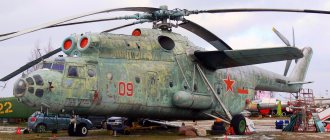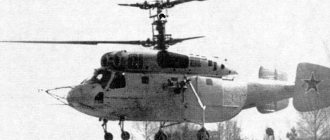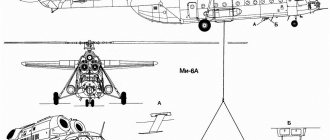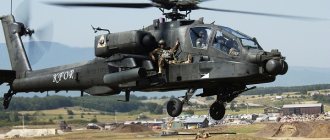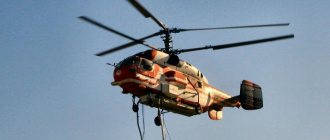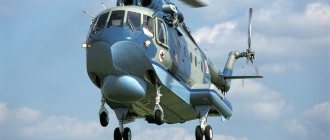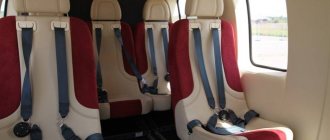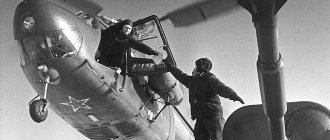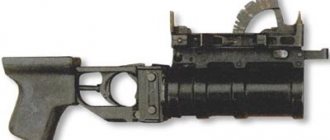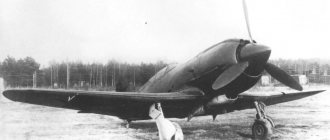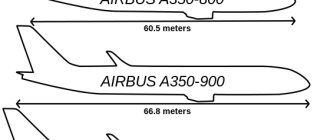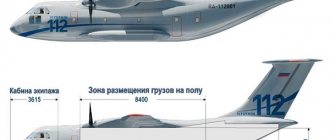Helicopter Ka-126 Engine. Dimensions. Story. Load capacity
The Ka-126 helicopter is a further development of the Ka-26 helicopter with one gas turbine engine instead of two engines. Design of the helicopter began in 1984, and initially a helicopter project with two gas turbine engines in small nacelles on the sides of the fuselage was considered, but preference was given to a helicopter project with one gas turbine engine on top of the fuselage.
In 1985, an agreement was concluded with the Romanian company IAR on the joint development of the Ka-126 helicopter and its mass production under license in Romania. At the beginning of 1986 A stand was built for ground testing of helicopter systems, and a year later the first experimental helicopter made its first flight. Then four pre-production helicopters were built, one of which was built in the USSR (made its first flight on October 19, 1988), and the rest in Romania (the first flight of the Romanian-made Ka-126 helicopter took place on December 31, 1988). The first 10 production helicopters, designated IAR Ka-126, were built in 1991. at the IAR plant in Brasov. It is planned to serially produce Ka-126 helicopters in Russia at an aircraft plant in Ulan-Ude.
The Ka-126 helicopters are equipped with one TVO-100 gas turbine engine from the Omsk Engine Design Bureau with a take-off power of 530 kW, which ensured a significant increase in the helicopter’s power supply and improved flight performance with a higher payload.
Modifications
Ka-126 helicopters were produced in two versions:
– multi-purpose and transport – with a cargo-passenger cabin;
– agricultural – without a cargo-passenger cabin with a large- and medium-drip sprayer or centrifugal spreader, and later – with an ultra-low-volume sprayer and a device for dispersing granular herbicides; The versatility of the Ka-126 is due to the possibility of attaching removable equipment for various purposes.
Passenger helicopter Ka-126
A modification of the Ka-128 was built - with one gas turbine engine of the French production Turbomeca “Arriel” 1D1 with a take-off power of 532 kW, which has the best flight characteristics with the same weight data as the Ka-126 helicopter. It is planned to mass produce Ka-128 helicopters at a plant in Ulan-Ude and to certify the helicopter according to FAA standards in the USA in 1996.
A modification of the Ka-226 was built - with a power plant of two American-made Allison 250-S20V gas turbine engines, with a take-off power of 308 kW each, ensuring greater flight safety and better flight characteristics.
Agricultural helicopter Ka-126
The helicopter's design is basically the same as the Ka-26, with extensive use of composite materials. The aerodynamic shapes have been improved by removing the engine nacelles, the gas turbine engine is located on top of the fuselage, and the nozzle is bent upward. The transmission system includes an inertial energy storage device with two counter-rotating flywheels, rotating at a speed of 24,800 rpm and providing the ability to continue flight for 40 seconds in the event of an engine failure. An air filter is installed in the forward part of the cabin. The rotor blades are equipped with an electrothermal anti-icing system.
The Ka-126 power plant consists of one TVO-100 turboshaft gas turbine engine, with a free turbine, developed at the Omsk Engine Design Bureau, with a takeoff power of 530 kW and a cruising power of 343 kW. The engine has a modular design, two axial and one centrifugal compressor, an annular combustion chamber and a two-stage turbine. Pressure increase ratio 9.2; output shaft rotation speed 6000 rpm. Engine length 1.275m, width 0.78m, height 0.735m, dry engine weight 160kg.
The helicopter is equipped with an improved main gearbox VR-126M, two-stage, planetary, with gears with Novikov gearing, which provides drive for coaxial rotors and assemblies; designed for single-engine helicopters Ka-126 and Ka-128 and twin-engine Ka-226.
Accidents
A Ka-29 helicopter crashed over the Baltic on the night of April 12-13, 2018 at about 11:30 p.m. Moscow time. The team of two test pilots died. A search operation was carried out at the scene of the incident, the bodies of the victims were found soon (a day later). On the night of April 13, the wind force at the crash site did not exceed 112 m/s, the wave height was more than one meter.
Columnist for the Komsomolskaya Pravda newspaper (military specialist) V. Baranets said that until all documents and data are processed, it will not be possible to name the exact cause of the accident. It is possible that in stormy conditions the vehicle could have landed on the landing deck, but an emergency occurred.
Experts will look into why the exercises were carried out during the storm and how experienced the crew members were. It is worth considering that people are trained in military affairs in conditions as close as possible to combat realities. After all, in war conditions, the enemy will not let you wait out the storm in peace. However, something didn't go according to plan.
In service
In service
Russia:
- Aviation of the Russian Navy - 27 Ka-29 as of 2020, assigned to the Northern Fleet, Pacific Fleet and Baltic Fleet.
- 12 (or 6?) repaired units at the Pacific Fleet as of November 2017.
a detachment of repaired helicopters at the Baltic Fleet (Donskoye airfield in the Kaliningrad region) as of November 2020.
Ukraine:
Aviation of the Ukrainian Navy - 4 Ka-29, as of 2020. After the collapse of the USSR, Ukraine received 5 Ka-29s, which were in service with the 555th Instructor and Research Anti-Submarine Mixed Aviation Regiment (Ochakov).
Equatorial Guinea - 1 Ka-29 as of 2020, purchased from Ukraine in 2011.
Description of design
Since the Ka-29 was based on the 27 division, its design was similar to the previous model, but with significant modifications and changes. The most noticeable modification was the redesigned bow cockpit, which featured three flat windshields, whereas the 27 model had two rounded windows. It was also produced in transport and combat versions, and is intended mainly for the following purposes: amphibious landing, cargo transportation, suspended transportation of military equipment.
Figure Ka-29
Weapons and equipment
The helicopter has a fairly large weapon system. Of these: a 9-A-622 machine gun of 7.62 mm caliber, 2 × universal gun containers UPK-23-250 with a GSh-23L cannon. The helicopter also has a rich missile and bomb armament: 9K113 Shturm-V TRK with 9M114 Cocoon or 9M120 Attack ATGM (up to 8 pcs.), 2 × ZB-500.
Modifications
There were several modifications in total. These were:
- Ka-252TB - prototype
- Ka-29 - serial transport and combat helicopter
- Ka-29VPNTSU - target designator helicopter
- Ka-31 (Ka-27RLD) - AWACS helicopter
Flight performance
| Type of characteristics | Ka-29 |
| Crew, people | 2 |
| Length, m | 12,25 |
| Height, m | 3,8 |
| Maximum operational overload, g | 2,3 |
| Normal take-off weight, kg | 11000 |
| Take-off weight at overload, kg | 11500 |
| Payload, kg | 1850 |
| Maximum speed, km/h / at altitude, m | 280 |
| Cruising speed, km/h / at altitude, m | 235 |
| Rate of climb at the ground, m/s | 15,5 |
| Practical ceiling, m | 3700 |
| Normal flight range, km | 460 |
Crew and passenger capacity
The helicopter crew consists of 2 people: a pilot and a navigator. Also, the helicopter can accommodate 10 wounded, while 4 people can be on stretchers. The total passenger capacity is 16 people.
Combat use
In 1995, 30 copies entered the Russian Navy. Currently, the Ka-29 is in service with the following countries:
Russia:
Russia – 30 units
Ukraine – 3 units.
Consisted of:
USSR
USSR – USSR Navy
Modifications
The main variant of the helicopter is the anti-submarine Ka-27PL or simply Ka-27.
Along with this machine, the following modifications were created:
- Ka-27E. Helicopter for radiation reconnaissance. The name “Advisor-SV” is also used;
- Ka-27PS. Search and rescue modification. One more person (medic) has been added to the crew. The development of this vehicle was a variant with an increased range - the Ka-27PSD;
- Ka-28. This designation was used for helicopters supplied abroad. The composition of on-board equipment in the export version is simplified;
- Ka-29. The helicopter for the Marine Corps is capable of transporting troops, providing them with fire support, and is also used for transporting cargo. The navigator-operator was excluded from the crew;
- Ka-31. Designed for long-range radar detection;
- Ka-32. A civilian multi-purpose version of the helicopter, it was widely exported. Additional submodifications could be used as firefighters, police, transport and auxiliary vehicles. The most unusual helicopter crane is the Ka-32A0.
Ka-32 helicopter during transportation of cargo on a cable
In addition, several variants of the Ka-27 were experimental. Among them are:
- Ka-252TL. Used for telemetry during testing of the ship's complex;
- Ka-27PV. It was demonstrated at the exhibition as a helicopter for maritime border guards. Armed with X-35 missiles;
- Ka-27PK. An experimental vehicle for combating enemy boats;
- Ka-27REP. Electronic warfare helicopter.
There were unrealized projects for several more variants of the machine. The most notable of these could be the mine-resistant Ka-27PS. The Navy was waiting for a similar helicopter, but it was never created.
The most advanced modification of the helicopter was the Ka-27M, which began entering service with the Navy around 2014.
Different types of headphones
It makes no difference what kind of headset you use, the main task is to find the right connector for connection. If necessary, you can use a special adapter that will help you avoid short circuiting the device. We recommend taking a look at the nuances of setting up connections for different types.
Headphones with microphone
Such devices are equipped with two outputs. To connect the component to the PC, you should find the corresponding sockets on the latter’s case. You also need to check the availability of the required software. Just go to the control panel and open the “Sound” tab, and from there go to “Recording”. In the window that opens, check the functionality of the device.
Professional equipment
Here we consider those models that are used on TV and radio. These headphones are distinguished by a plug that has a larger diameter (6.5 mm). These gadgets can also be used on a regular connector if you buy a special adapter.
You can try to recreate such an adapter with your own efforts: take a classic 3.5 and connect it to a socket of a larger diameter using a wire.
Old models
Such devices have a very old ONTs-VG type output, which you will not be able to connect without the necessary adapter. You can create the latter yourself for this case too.
To carry out such work, an ohmmeter is useful, which is often installed in the “classic set” of any multimeter:
- Using a meter, check the pinout of all contacts on the connectors: if it is connected between the output and the common channel of one of the two contacts, then characteristic clicks will be heard. If these sounds are heard in two channels, then this connection is suitable.
- After identifying the channels, start making an adapter using the same jack plug.
An indispensable all-rounder
Most likely, separate detachments of each of the military fleets will receive from four to eight combat vehicles, says military expert Dmitry Boltenkov.
“Currently, the Navy has about one and a half dozen such helicopters,” he told Izvestia. “The industry has proven that it is possible to modernize a certain number of these universal vehicles that the fleet really needs. They are indispensable when landing troops or special forces groups, patrolling the water area. The Ka-29 can be sent on long voyages on large Project 1155 anti-submarine ships, which became famous during anti-terrorism operations against Somali pirates. In addition, patrol ships of Project 22160 of the Dmitry Rogachev type can be armed with helicopters.
ka29
Ka-29 helicopter against the background of the aircraft-carrying cruiser Admiral Kuznetsov
Photo: RIA Novosti/Andrey Luzik
The vehicle will be in demand everywhere due to its firepower, carrying capacity and unique landing capabilities, the expert noted.
Advantages and disadvantages
The Ka-27 helicopter has many positive qualities for which it is valued by both military sailors and civilian customers.
An approximate list of the advantages of this machine is as follows:
Significant load capacity of the machine; High level of automation of piloting and navigation. Easy maintenance; The helicopter is insensitive to side winds, which is especially important when landing and hovering; The robust chassis allows you to land even on small ships in rough seas, confidently absorbing the impact on contact.
Some pilots consider the machine's disadvantages to be the excessive, in their opinion, complexity of the on-board equipment, which sometimes leads to malfunctions and failures. This equipment itself on the main modifications of the helicopter has long been outdated and needs to be replaced, especially the sonar and PS (hydroacoustic station and search system).
Ka-27M helicopter with suspended Kh-35 anti-ship missile
In addition, the accident rate of the Ka-27 and Ka-32 is quite high - at least 20 of these vehicles were lost as a result of accidents that resulted in the death of people.
Upgrading to the Ka-27M level will significantly improve the helicopter's performance. It is simply impossible to replace this machine in the navy, so it is guaranteed to have a fairly long life.
Author of the article:
Fedorov Dmitry
Helicopter Ka-15 Engine. Dimensions. Story. Range of flight. Static ceiling
The naval command, inspired by the successful tests of the Ka-10 on ships, in 1953 proposed to N.I. Kamov to create a ship-based helicopter with greater capabilities than its predecessor. The future Ka-15 was developed for the AI-14R engine with a take-off power of 245 hp. The design of the two-seater began in the summer of 1950 at OKB-3 in Sokolniki, then it was designated as “product B”. The following year, a preliminary design was completed and a mock-up of the machine was presented to the customer. By that time, Kamov’s team, like Mil, celebrated a housewarming party on the territory of plant No. 82 in Tushino, where a new experimental helicopter design bureau OKB-4 was created.
Black Shark and Alligator
In the mid-80s, the winner of the competition was announced: it turned out to be the Kamov Design Bureau and its K-50 “Black Shark” helicopter. The coaxial design of this machine has both its advantages and disadvantages. Such helicopters are more complex and more expensive than classic ones, and their maintenance is also more expensive. On the other hand, the use of two main rotors makes it possible to remove the tail rotor and thereby seriously increase the efficiency of the engine and make the helicopter more maneuverable and mobile. The weight of the machine also becomes lighter compared to classical helicopters. But it is more difficult to control such a helicopter; high skill of the pilot is required.
The problem with the K-50 was that this helicopter was controlled by only one person. Effectively driving a car and aiming a weapon at the same time is very difficult, especially in difficult conditions (mountains, low-altitude flight), so in the mid-90s the development of a new machine began - it became the Ka-52 combat helicopter. In fact, this machine is a modernization of the Black Shark, and many components and assemblies of these helicopters are identical.
Combat use
To test the capabilities of the Ka-29 and Ka-50 in real combat conditions, on the basis of the 696th OIVP, the so-called. combat strike group
. The Kamov company, at its own expense, prepared two Ka-50s and two Ka-29s for operations in the Caucasus; the Ka-29s were from the Center.
One Ka-29 helicopter (No. 38) was equipped with a 2A42 automatic cannon, the second helicopter (No. 35) was converted into an airborne guidance and target designation point, equipped with the appropriate equipment (Rubicon sighting, flight and navigation complex and an integrated on-board radio display and computing system , similar to those used on the Ka-50). To increase survivability, both Ka-29s were equipped with screen-exhaust devices (ESD) and cassettes with false thermal targets.
Testing of the modified helicopters took place from September 25 to October 21, 1997 at the Apabino training ground. Then, from December 1999 to July 2000, the Ka-29VPNTSU carried out another 250 flights, working together with the Ka-50 on the use of all types of weapons and techniques for using external target designation in a group of helicopters.
On November 24, 2000, a directive was issued from the Chief of the General Staff of the Armed Forces of the Russian Federation on sending a combat strike group (BUG) of two Ka-50s and one Ka-29VPNTSU to the North Caucasus. The personnel of the group consisted of eight pilots and navigators, 26 aviation engineering service specialists from the 344th Center, two representatives of the Army Aviation Department, nine employees of Kamov OJSC and the Kumertau APP.
The helicopters were based at the Grozny-Severny airfield. Combat sorties were carried out from January 6, 2001 to February 14.
Description
The main external difference between the Ka-29 and the Ka-27 is the extended bow of the cockpit with three flat windows instead of the latter's two double-curved windows.
The helicopter crew consists of two people: a pilot and a navigator-operator.
The Ka-29 helicopter is produced in two main versions: transport and combat, and is designed for landing marine units from ships, transporting cargo, military equipment on an external sling, as well as fire support for the marine corps, destroying enemy personnel, equipment and coastal fortifications. Can be used for medical evacuation, transfer of personnel, cargo from floating bases and supply ships to warships.
In the transport version, the helicopter is capable of carrying 16 paratroopers with personal weapons, or 10 wounded, including four on stretchers, or up to 2000 kg of cargo in the transport cabin, or up to 4000 kg of cargo on an external sling. The helicopter can be equipped with a winch with a lifting capacity of up to 300 kg.
In both versions, the helicopter is armed with a built-in four-barrel mobile 7.62 mm 9A622 machine gun mount with 1,800 rounds of ammunition, controlled by a navigator-operator. The machine gun is installed in the forward part of the fuselage and has the ability to rotate from 0° to −31° down, as well as to the left by 28° and to the right by 30°. In addition to the machine gun, universal cannon containers UPK-23-250 with a double-barreled GSh-23L cannon of 23 mm caliber and 250 rounds of ammunition can be suspended. A fixed 30-mm 2A42 cannon with 250 rounds of ammunition and a laser rangefinder coupled with an ASP-17VK aircraft rifle sight can be installed on the left side. Guided missile weapons are represented by the 9K113 "Shturm-V" anti-tank missile system (9M114 "Cocoon" and 9M120 "Ataka" anti-tank guided missiles - up to 8 pcs.) Unguided missile weapons - unguided aircraft missiles of the S-5 type, 57 mm caliber in 2-4- x UB-32 blocks - 64-128 pcs. or S-8 caliber 80 mm in 2-4 blocks B-8V20A - 40-80 pcs. It can also carry bomb weapons in the form of two incendiary tanks of the 3B-500 type. The suspension of weapons on the helicopter mounts is provided by the on-board cargo lifting system - a winch with a lifting capacity of up to 500 kg.
Performance characteristics
The Ka-29 has the following characteristics:
- Crew – 2 people.
- The diameter of the main propeller is 15.9 m.
- Height - 5.44 m.
- Length - 12.25 m.
- Width - 3.8 m.
- The normal take-off weight is 11,000 kg.
- The maximum take-off weight is 12,000 kg.
- Engine type – Klimov 2 GTD TV3-117VK.
- The maximum speed of the helicopter is 280 km/h.
- Cruising speed is 235 km/h.
- The practical range is 460 km.
- The ferry range is 740 km.
- The dynamic ceiling is 4300 m.
- The static ceiling is 3700 m.
- The payload is 4000 kg on the sling or 2000 kg of cargo in the cabin, as well as 6 seated wounded and 4 stretchers or 16 soldiers.
Short description
The Ka-29 combat helicopter is equipped with a surveillance and sighting system; on the external suspension there are four holders for cylinders responsible for firing. In the transport version, the aircraft was equipped with weapons in the form of a 7.62 mm machine gun. The magazine capacity was 1800 rounds of ammunition. The combat analogue provides for the additional installation of several types of weapons. Among them:
- Anti-tank missiles "Sturm" (up to eight pieces).
- Unguided aircraft warheads of the S-80 type (up to 80 pieces).
- Cannon installations with a caliber of 23 mm.
- 30mm anti-aircraft guns 2A42.
It is worth noting that navigation, flight and auxiliary systems allow the Ka-29 helicopter to be used at any time of the day or night, regardless of weather conditions.
Structural elements
The Ka-27 combat helicopter is equipped with three-blade counter-rotating propellers that fold when stationary on the ship. The blades of these propellers are made of fiberglass, and their bushings are made of titanium.
The fuselage of the vehicle is made of solid aluminum alloy. To ensure stable provision of both longitudinal and directional stability of the helicopter, a tail unit with two fins is used. The washer of each fin has an uncontrolled slat and is turned with its toe towards the axis of the fuselage itself.
The landing gear has four non-retractable legs and is equipped with a hydraulic system for slightly lifting the helicopter in order to provide convenient access to the cargo compartment. A characteristic feature of the front wheels is self-orientation. It is also possible to install skis.
Inside the Ka-29
Cargo compartment of the Ka-29
Tail compartment of the Ka-29 cargo compartment
80 mm NAR B-8 blocks
Similar
Mi-28N Night Hunter Armament. Speed. Engine. Dimensions. Story
Helicopter Mi-24 Speed. Engine. Dimensions. Story. Range of flight
Ka-52 Alligator Armament. Speed. Engine. Dimensions. Story
Helicopter Mi-8 Engines. Dimensions. Weight. Story. Range of flight
Helicopter AH-64 Apache Speed. Engine. Dimensions. Story. Range of flight
Ka-50 Black Shark Armament. Speed. Engine. Dimensions. Story
Helicopter Mi-26 Engines. Dimensions. Load capacity. Story. Range of flight
Helicopter CH-47 Chinook Speed. Engine. Dimensions. Story. Range of flight
Helicopter Mi-2 Speed. Engine. Dimensions. Story. Range of flight
Helicopter Mi-6 Load capacity. Engine. Dimensions. Story. Range of flight
Helicopter Bell UH-1 Iroquois Armament. Speed. Dimensions. Engine
Helicopter Mi-12 Engines. Dimensions. Weight. Story. Load capacity
Helicopter Ka-27 Speed. Engine. Dimensions. Story. Range of flight
Helicopter Ka-62 Engine. Dimensions. Weight. Story. Range of flight
Helicopter Mi-4 Engine. Dimensions. Weight. Story. Range of flight
Helicopter Ka-26 Engine. Dimensions. Weight. Story. Range of flight
Helicopter Ka-226 Engines. Dimensions. Story. Weight. Range of flight
Helicopter Mi-38 Engine. Dimensions. Weight. Story. Range of flight
Helicopter Mi-34 Engines. Dimensions. Weight. Story. Range of flight
Helicopter Mi-14 Speed. Engine. Dimensions. Story. Range of flight
Helicopter Yak-24 Engines. Dimensions. Weight. Story. Load capacity
Helicopter Ka-29 Speed. Engine. Dimensions. Story. Range of flight
Helicopter Mi-1 Engine. Dimensions. Weight. Story. Range of flight
Helicopter Ka-60 Killer whale Speed. Engine. Dimensions. Story. Range of flight
Helicopter Mi-10 Engines. Dimensions. Weight. Story. Load capacity
Helicopter B-7 Speed. Engine. Dimensions. Story. Range of flight
Helicopter AH-1 Cobra Speed. Engine. Dimensions. Story. Range of flight
Helicopter Ka-25 Speed. Engine. Dimensions. Story. Range of flight
Helicopter Ka-118 Engine. Dimensions. Story. Load capacity
Helicopter Ka-10 Engine. Dimensions. Story. Weight. Range of flight
Helicopter Ka-8 Irkutsk Speed. Engine. Dimensions. Story. Range of flight
Helicopter Ka-15 Engine. Dimensions. Story. Range of flight. Static ceiling
Helicopter Ka-22 Engines. Dimensions. Weight. Story. Range of flight
Helicopter Ka-126 Engine. Dimensions. Story. Load capacity
Helicopter Ka-37 Engine. Dimensions. Story. Range of flight
Helicopter Ka-31 Engine. Dimensions. Story. Range of flight. Static ceiling
Helicopter Ka-18 Engine. Dimensions. Story. Weight. Range of flight
You have no rights to post comments
Features of the Ka-31 aircraft
The Navy used the helicopter to detect surface ships and air targets and escort them if necessary. Those units that were based directly on ships were used as air defense support for combat formations of the entire fleet. The powerful radar is mounted on solid-state elements and, when turning during flight, can release the antenna along with the phased array (phased array antenna).
Thanks to the onboard radio-electronic complex installed on the helicopter, the Ka-31 can fly automatically along a programmed route, regardless of weather and climatic conditions. The AWACS helicopter is capable of simultaneously detecting and tracking up to twenty objects.
The automated mode facilitates fast and, most importantly, automatic transmission of information about found targets to the control center. Transmission is carried out using a telecode channel. The “Oko” or E-801 system, created at the Research Institute of Radio Engineering (Nizhny Novgorod region), allows you to detect any surface or low-level object at long-range radar frequencies.
The antenna is specially attached to the bottom of the Ka-31 to reduce aerodynamic drag and prevent it from deteriorating during landing. In operation, the antenna tilts 90 degrees and the landing gear rises. The headlamps together with the radar weigh about 200 kg, the antenna rotation area is six square meters, and the length reaches 5.75 meters. A surface object is detected at a distance of more than 250 kilometers, and an air object is detected at a distance of up to 150 km.
Especially for helicopters of the detecting and reconnaissance classes, the Instrument Design Bureau (Saratov) developed a flight navigation complex (FNC). The general operating mode of the radar and PNK is simple. When the radar is operating, the PN complex establishes stabilization of the angular position, is responsible for the barometric or true flight altitude, determines the flight in the sentinel zone of a typical trajectory, automatically brings the vehicle to a ship or airfield, and also makes it possible to bring the helicopter to the landing point using radar landing signals .
The transmission of the received information via closed and open channels is carried out by a special communication complex installed on the Ka-31 AWACS. Transmission is carried out by telecode channel. The helicopter can transmit information at a distance of 150 km from its home base, and at the same time the altitude can reach 1500-3000 meters. Flight parameters are recorded automatically using specialized recording equipment “Tester-3K”.
In addition to naval use, the helicopter can also be used for ground forces. The Ka-31 is capable of being deployed at small unprepared sites that are located near mobile anti-aircraft missile launchers. AWACS provides pointers to the target.
But mass production ended before it really began. The Russian Navy began the complete elimination of ships designed under number 1143, which led to a loss of interest in the Ka-31 helicopter. Only two copies are in use. They are located at the Admiral Kuznetsov aircraft carrier base. They wanted to increase the number of Ka-31s in connection with the purchase of special Mistral helicopter carrier docks from France, but due to the imposed European sanctions this will not happen. The scandal occurred due to Russia's support for separatists in Ukraine.
"Octopus"
This is the name of the special on-board complex, which includes:
- A radar station that solves navigation problems and searches for submarines that have surfaced. The system fairing is located on the nose of the fuselage.
- Lowered hydroacoustic station. It is located in the rear section of the fuselage and determines the coordinates of submarines.
- Calculation and sighting device. Provides automatic launch of the helicopter to a point for subsequent release of destructive weapons.
- Radiohydroacoustic type buoy.
- The detector is magnetic.
In addition, the Ka-27 anti-submarine helicopter is capable of dropping markers, smoke generators, and transponder beacons.
Surface targets this combat aircraft detects during flight at an altitude of up to 500 m:
- If the EPR is up to 250 m - at least 25 km.
- If the EPR is 2 m - at least 5 km.
Control
The precision of the Ka-29 helicopter is controlled by moving the control stick using automatic skewing. They are connected to each other through traction and constantly changing angles of the blades. As a result, a common vector of aerodynamic forces of a pair of propellers is provided, deviating in the required direction by the required amount. The symmetry of aerodynamics is guaranteed by the balance of reactive effects and the absence of a rudder propeller.
The Ka-29 helicopter, whose history continues to this day, has the ability to create different torques, thanks to the deflection of the pedal with differential movement of the pitch of the upper and lower rotor. The mechanism helps the blade mounting angles increase on one propeller while reducing the force on the second propeller. In this case, the total thrust does not change.
A symmetrical aircraft in the aerodynamic direction does not require consideration of wind or other weather features when performing combat maneuvers in a hovering or moving position. This ability has a positive effect on takeoff or landing from the deck of a moving aircraft carrier.
History of the Ka-31
The need for any country with sea cordons for AWACS became clear during the military conflict between England and Argentina over the disputed Falkland Islands. The Argentine Air Force had the advantage of low-flying aircraft, which sank two British ships: Coventry and Sheffield. The British could not intercept the planes because they did not have AWACS radars.
It was for these reasons that the N. Kamov Design Bureau received the task in 1985 to create an AWACS helicopter. It was based on a glider, power and load-bearing systems from the Ka-29 helicopter. The only difficulty was finding a way to install a radar on the helicopter. Various problems arose: unstable flight and constant shaking when the radar rotated, a conflict between the radar systems and other navigation equipment. The first OP took off in 1987, and the helicopter entered the ranks of the Russian Navy only in 1995. Serial production for naval aviation was carried out at the Kumertau plant.
Various modifications
The very first modification of the Mi-28A did not find its serial solution, since it did not meet the standards and norms of a helicopter operating around the clock. The Mi-28N, or “Night Hunter,” on the contrary, showed itself well and was put into mass production. Its difference was the installation of a more modified avionics. Missile guidance is carried out by the Tor complex, produced at the Krasnogorsk Plant named after Zverev OJSC. The lower hemisphere is surveyed by TOES521, and the updated OPS helps with night flights.
- Mi-28 is an experimental prototype. Coded as "product 280".
- Mi-28A - “product 286”. A modernized model with TV3-117 engines, fiberglass spars, equipment, and X-shaped RV 286-1.
- Mi-28L – licensed Mi-28A for use in Iraq.
- Mi-28N is a helicopter for night operations. Main gearbox VR-29.
- Mi-28NE – export version.
- Mi-28NM – modernized Mi-28N. Development is still underway.
- Mi-28UB - the helicopter is used for training purposes.
Ka-29 helicopter - video
https://youtube.com/watch?v=OHvmfA4Dlog
In the combat version, the Ka-29 is equipped with a surveillance and sighting system, and on the external sling there are four beam holders for weapons. If in the transport version the Ka-29 was equipped only with a 7.62 mm machine gun (1800 rounds), then in the combat version it can carry a variety of weapons. Including up to eight Sturm anti-tank missiles, 80 S-8 unguided aircraft missiles, two universal gun containers with 23-mm cannons and ZB-500 incendiary tanks. The helicopter has the ability to install a 30-mm 2A42 cannon with 250 rounds of ammunition.
Flight navigation, radio communication and sighting equipment allows the Ka-29 to be used at any time of the day and in difficult weather conditions.
On October 18, 1991, during the flight of the Ka-29 helicopter to the training ground for the integrated use of weapons against ground targets (according to exercise 344 of the ASV-92 combat training course), 31 minutes after takeoff from the Torzhok airfield at an altitude of 300 m and a speed of 195 km/h, the crew noticed an increase in the oil temperature in the main gearbox to 75 degrees and extraneous noise. At the same time, the right engine indicator light came on and it was automatically turned off by the limit mode regulator. After the right engine stopped, the vibration of the helicopter increased and the red display lit up. Then the pressure in the main gearbox dropped.
Having received the report of the on-board technician, the crew commander, Captain O.N. Myagkov reduced the engine speed, and then, on the orders of the commander, the crew left the helicopter using parachutes. The helicopter fell to the ground in an uncontrolled flight.
Helicopters of this type, designated Ka-27TB, were in service with the Russian FSB and in 2007 (at least two vehicles) were put up for auction.
It was also acquired by China, India, Vietnam and Yugoslavia.
Modifications
Ka-252TB - Prototype.
Ka-29 - Serial transport and combat helicopter.
Ka-29VPNTSU - Target designator helicopter.
Ka-31 (Ka-27RLD) - AWACS helicopter.
Modernization
— In 2012, the modernization of 10 Ka-29 transport and combat helicopters, intended for the Mistral-type UDC, began. Modernization consists of installing modern weapons and radio-electronic base.
— In December 2020, the repair of a batch of 6 Ka-29s was completed, which will arrive at the Pacific Fleet. The helicopters' main rotor columns, engines and gearboxes were overhauled, and the paintwork was updated.
— Another batch of 6 aircraft that underwent a scheduled mid-life repair at the Kumertau Aviation Production Enterprise arrived at the Nikolaevka Pacific Fleet naval aviation airbase in the Primorsky Territory on November 9, 2017.
— In November 2020, at the Donskoye airfield in the Kaliningrad region, a detachment of updated Ka-29s was put into operation, having undergone repairs at the 150th aircraft repair plant.
Inherent avionics
The main developer of avionics for the Mi-28N is the Federal Research and Production Center RPKB. Onboard radio-electronic equipment provides:
- helicopter combat readiness regardless of weather conditions and time of day;
- automatic target distribution;
- performing assigned tasks at very low altitudes;
- productive interaction in a team or group with air or ground units;
- parallel or joint actions to engage targets by the operator or pilot;
- the ability to service a helicopter at long distances from its deployment point;
- adaptation of new TSA.
The complex consists of the following:
- one computing system. It provides complete information processing based on the Baguette-53 computer;
- the latest BUT with the presence of a high-precision INS-2000 and a vertical heading SBKV-2V-2;
- the cockpit information field consists of liquid crystal displays and a multifunctional remote control;
- laser and electronic irradiation detection system;
- weapons control system; self-propelled gun system;
- helmet-mounted target designation and display system;
- pilot surveillance system with night vision function (consisting of a thermal imaging channel, a low-level TC and a laser rangefinder);
- surveillance and targeting system for object detection, recognition and aiming;
- aerobatic complex;
- onboard communications complex KSS-28N-1. Responsible for automatic data exchange between the helicopter and the ground command post. Capable of operating in frequency converter and frequency response modes.
The avionics also includes a heat-TV machine of the “Okhotnik” family, which functions for intelligent processing of video images for inspection of the background target picture, regardless of the time of day and weather conditions. In addition, the Mi-28N can indicate (highlight) a target for fighters or other helicopters.
The Mi-28 has rare abilities. For example, if the helicopter was damaged, was shot down, or began to break apart throughout the entire structure, the propeller blades, doors, console and wings are disconnected, then the pull straps are cut, and balloons are inflated to ensure safe exit from the cabin. The crew lands using parachutes.
The survivability of the Mi-28 is ensured by highly resistant armor that can withstand a direct hit from armor-piercing bullets (12.7 mm caliber) and fragmentation shells (20 mm).
The crew cabin is constructed of aluminum sheets (10 mm), onto which ceramic armor elements (16 mm) are glued. The cabin doors are made of fiberglass (composed of an aluminum plate and ceramic armor). The glass in the front compartment is made of a 42 mm silicate block, in the doors and sides - 22 mm.
The operator's and pilot's cabins are separated from each other by an aluminum armor plate 10 mm thick. The anti-fire effect in fuel tanks is provided by polyurethane foam filled along the casing and latex self-tightening protectors.
This helicopter is capable of flying at a very low altitude, up to five meters, bending the terrain. Increased maneuverability allows the helicopter to move backwards and to the sides. And thanks to the EDU (screen-exhaust devices), the visibility of the Mi-28 in the infrared range is halved.
A special hardware installation of radio interference provides protection against guided missiles and IR homing heads.
The Mi-28N is the first helicopter to use elastomer-type spherical joints; they do not require lubrication.
This helicopter is in service in countries such as Russia, Iraq, Egypt, Algeria.
